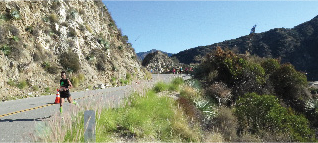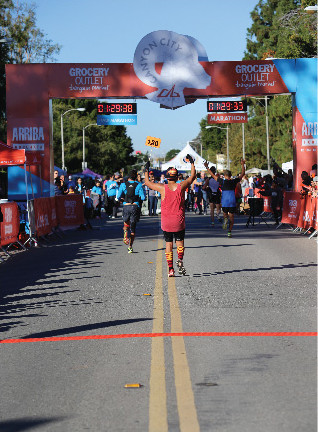Downhill Racing — Unique, Demanding, and Rewarding
REVEL is known for fast and beautiful downhill courses. The amount of downhill is what makes REVEL races remarkably unique. There are many "net downhill" races out there, but REVEL has a series of races that consistently rank in the top 10 fastest marathon and half marathon courses anywhere – including the #1 fastest course in the country.
Preparing for a fast downhill course doesn't require any special skill as a runner. Downhill racing does place unique demands on your body, but as a distance runner you already have the well-developed muscle structure to handle the physical challenges of all the blazing-fast REVEL courses. The key to a successful and rewarding downhill race is to learn proper downhill form, train with the right amount of downhill volume and intensity, and otherwise prepare your entire body – legs, back, shoulders, arms, and even head position – for the physical demands that make a downhill course different from most other courses.
Learning Downhill Form
The main challenge with downhill courses is not so much the forces created with running downhill, but mostly from the inefficiency of improper downhill form.
Although there are no "secret methods" or special "running tricks" for downhill running, there are certain techniques that you can develop to maintain efficiency, stride rate, momentum, and speed on a downhill course. The key is to learn proper downhill form, to practice it regularly, and to reach a level of comfort with the form – and the higher speed – for downhill racing.
The REVEL Online Coaching Program includes videos, notes, and workouts specifically designed to prepare runners of all experience levels for REVEL's downhill courses!

Downhill Form — The Mistakes and the Corrections
Mistake: BrakingThe most common form mistake in downhill running is "braking" with every step. Runners who are uncomfortable running downhill will lean back, brace themselves for every footfall, and essentially cover 13.1 or 26.2 miles "driving with their foot on the brake." Not only does this slow the pace, but it produces unnecessary forces on the body with each step. |
Correction: Pitch ForwardTo help avoid braking, you should "pitch forward" with the hill, not lean back against it. This doesn't mean to stick your head and shoulders forward into a hunched position. It means to keep your head high, with shoulders upright, but tilt forward at the hips to get a sense of "falling forward with gravity." As a reminder, mentally remind yourself to "keep my nose ahead of my belly- button." |
Mistake: Bounding or OverstridingAnother common mistake in downhill running is "overstriding," where runners take long, loping steps that almost create a bounding gait. Taking huge pounding steps is a mistake that is based on the misguided notion that "longer strides cover more ground," and is severely debilitating to runners on downhill courses. Over the course of 13.1 or 26.2 miles, the knees, quads, and hips are taxed unnecessarily, leading to muscle fatigue, mid-race soreness, and discomfort that will slow any runner down. When runners overstride with a lot of intensity – even in training – the result can be extreme soreness, and can lead to injury. |
Correction: High Turnover, Short StrideOn a downhill course, remember that high leg turnover is critical to maintaining pace, momentum, and efficiency during your entire race. On a gradual downhill segment of a course, you should feel a "gliding" or "floating" sensation, almost as if the ground were a giant treadmill beneath you, and all you have to do is keep up by maintaining a high stride rate, or "leg turnover." At the same time, you should focus on a shorter stride length, not longer. Stride length and turnover go hand-in-hand on a downhill course. Shorter stride supports higher turnover, and vice-versa. That's key for maintaining an efficient, fast, and consistent pace throughout your race. |
How Often, How Far, and What Type of Workouts?
There are a number of downhill training methods and workouts that help runners find their optimum amount of downhill training, meaning the appropriate level of intensity depending on experience level, and the adequate number of days and proper distances for downhill "practice" during the weeks leading up to race day. The tricky part is determining the optimal frequency and intensity for your training – hitting the right balance between "too much" and "not enough." Every runner is different, and what's right for someone else isn't necessarily right for you.
Generally, you should include downhill training hill workout about once every 10-14 days. This doesn't mean you should avoid hills for your daily runs if you live in a hilly area. Go ahead with your regular running on your normal routes. However, a "hill workout" is one that emphasizes form and technique over distance or pace. Hill workouts place a lot of load and stress on your legs; and excessive number of hill workouts can lead to injury.
Likewise, hill workouts typically should be a bit lower on mileage than most other runs. A 5-mile easy run is a lot less stressful on your body than a 5- mile hill workout. Again, overdoing it with mileage on a hill workout creates a higher chance of injury.
As you prepare for a REVEL race, the types of hill workouts that will benefit you the most are downhill repeats of distances ranging from 1/4 mile up to 1 mile in length, although more advanced runners can practice sustained downhill intensity for longer distances. Whatever your experience level, your training should include enough downhill distance to allow you to practice your form, but without putting enormous strain on your legs.
Downhill Intensity - How Much is Too Much?
On all of REVEL's unbelievably fast courses, your best friend is gravity. Racing on REVEL's downhill courses requires a notably lesser amount of effort than what is typically required in other marathons and half-marathons. In order to reap the benefit of the efficiencies gained from REVEL's downhill courses, you should be prepared to run faster than you normally run. Fighting your downhill momentum wastes energy, so you will want to take advantage of gravity by using efficient downhill form to maintain -- not resist – the added speed that you'll find on REVEL's courses.
"Faster than you normally run" is a phrase that can be daunting for runners who haven't trained adequately for the added speed of downhill racing. This "faster-than-usual speed" is not just for a few miles – it is for the majority of the REVEL courses. As you prepare yourself to experience one of the fastest courses you'll ever run, you have to train with faster than normal pace in downhill workouts. How fast? Generally, you should train to become comfortable running anywhere from 15 to 20 seconds per mile faster than normal, and include enough training to be capable of sustaining that pace for many miles. More experienced runners should be able to sustain paces 20-30 seconds per mile faster than normal, or more. Again, every runner is different, and you will have to include training workouts that help you find your "sweet spot" for fast downhill miles; not too fast, but not slowing yourself down unnecessarily.
The REVEL Online Coaching Program is designed with specific hill workouts every month, and includes periodic downhill repeats as part of a weekly long run.

What About Altitude?
REVEL is known for its fast and beautiful mountain courses.
Mountains mean altitude.
Don't sweat the altitude. The cardiovascular requirements for downhill running are significantly reduced compared to running on flat and uphill courses. Additionally, atmospheric oxygen levels will increase as you descend the REVEL courses, allowing you to benefit from increased oxygen intake as you get further and further along in your race. The positives of downhill running far outweigh the negatives of higher elevations, especially when you use proper downhill form and have trained to run faster than you normally run.
The REVEL Online Coaching Program includes pace charts that help runners find their proper "downhill pace" for workouts and racing.
What About Treadmill Training or on Flat Courses?
For runners who are unable to train on hills, there are ways to simulate downhill training. On a treadmill with a decline option, the answer is simple: follow the form, duration, and intensity tips above, but practice and train using the treadmill's decline. Although it's not quite the same as running an actual downhill workout, you can simulate downhill running on a treadmill.
If you don't have access to a treadmill with a decline option, the next best option is speed work on a track or flat course, especially speed work that emphasizes sustained paces that are faster than you normally run. The options for speed work are far too numerous to include here, but generally you want to find speed workouts that are designed for marathon or half-marathon training. Speed sessions that are geared towards 5Ks or 10Ks aren't the same as those for longer races.
One often-overlooked option is a parking garage. Although it can be a bit "twisty" with numerous and frequent turns, the same principles apply: practice downhill form and get used to faster-than-normal speeds. One note: Be careful about cars in parking garages. Drivers aren't accustomed to encountering runners dashing around corners in parking garages!
Training Tip of The Month
- Downhill workouts should include some level of uphill work too. The idea is to get used to running fast downhill on tired legs. The uphill climbing of the workout should put some stress on your legs, but don't overdo it: the uphill part isn't the focus, so don't go too hard while climbing. Instead, maintain a steady, even effort as you climb, and then work hard on your downhill form and speed as you descend.
The REVEL Online Coaching Program includes regular and structured speed workouts designed to prepare you for running faster than you normally run.
If you are looking for coached training from a veteran marathon and half-marathon coach (who has run all of REVEL’s races and is a multiple Boston Qualifier himself), consider the REVEL Online Coaching Program.
 0
0





